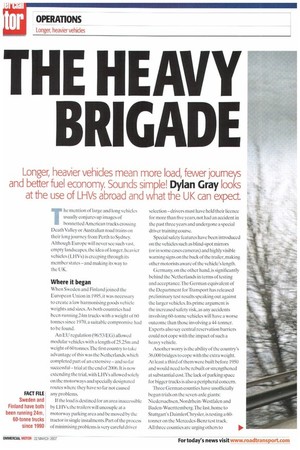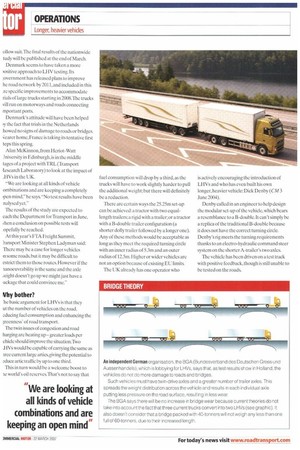THE HEAVY
Page 50

Page 52

Page 53

If you've noticed an error in this article please click here to report it so we can fix it.
BRIGADE Longer, heavier vehicles mean more load, fewer journeys
and better fuel economy. Sounds simple! Dylan Gray looKs at the use of LHVs abroad and what the UK can expect.
The mention of large and long vehicles usually conjures up images of bonnetted American trucks crossing Death Valley orAustralian road trains on their long journey from Perth to Sydney. Although Europe will never see such vast, empty landscapes, the idea of longer. heavier vehicles (LHVs) is creeping through its member states — and making its way to the UK.
Where it began
When Sweden and Finland joined the European Union in 1995, it was necessary to create a law harmonising goods vehicle weights and sizes. As both countries had been running 24m trucks with a weight of 60 tonnes since 1970, a suitable compromise had to be found.
An EU regulation (96/53/EG) allowed modular vehicles with a length of 25.25m and weight of 60 tonnes,The first country to take advantage of this was the Netherlands, wh ich completed part of an extensive — and so far successful —trial at the end of 2006. It is now extending the trial,with LHVs allowed solely on the motorways and specially designated routes where they have so far not caused any problems.
If the load is destined for an area inaccessible by LI IVs, the trailers will uncouple at a motorway parking area and be moved by the tractor in single instalments. Part of the process of minimising problems is very careful driver selection —drivers must have held their licence for more than five years. not had an accident in the past three years and undergone a special driver training course.
Special safety features have been introduced on the vehicles such as blind-spot mirrors (or in some cases cameras) and highly visible warning signs on the back of the trailer, making other motorists aware of the vehicle's length.
Germany. on the other hand, is significantly behind the Netherlands in terms of testing and acceptance.The German equivalent of the Department for Transport has released preliminary test results speaking out against the larger vehicles, ts prime argument is the increased safety risk, as any accidents involving 60-tonne vehicles will have a worse outcome than those involving a 44-lonner. Experts also say central reservation barriers could not cope with the impact of such a heavy vehicle.
Another worry is the ability of the country's 36,000 bridges to cope with the extra weight. At least a third of them were built before 1950 and would need to be rebuilt or strengthened at substantial cost.The lack of parking space for bigger trucks is also a peripheral concern.
Three German counties have unofficially begun trials on the seven-axle giants: Niedersachsen, Nordrhein-Westfalen and Baden-Wuerttemberg.The last. home to Stuttgart's DaimlerChrysler, is testing a 60tonner on the Mercedes-Benz test track. All three counties are urging others to ollow suit.The final results of the nationwide tudy will be published at the end of March. Denmark seems to have taken a more 5ositive approach to LHV testing. Its ;overnment has released plans to improve he road network by 2011, and included in this ,re specific improvements to accommodate rials of large trucks starting in 2008.The trucks vill run on motorways and roads connecting mportant ports.
Denmark's attitude will have been helped iy the fact that trials in the Netherlands howed no signs of damage to roads or bridges. 4earer home, France is taking its tentative first teps this spring, Alan McKinnon,from Heriot-Watt Iniversity in Edinburgh, is in the middle (ages of a project with TRL (Transport Zesearch Laboratory) to look at the impact of .,HVs in the UK.
"We are looking at all kinds of vehicle ombinations and are keeping a completely ipen mind," he says."No test results have been nalysed yet."
The results of the study are expected to each the Department for Transport in June, vhen a conclusion on possible tests will opefully be reached.
At this year's FTA Freight Summit, 1-ansport Minister Stephen Ladyman said: There may be a case for longer vehicles in some roads, but it may be difficult to estrict them to those routes. However if the tanoeuvrability is the same and the axle might doesn't go up we might just have a .ackage that could convince me."
Vhy bother?
lie basic argument for LHVs is that they ut the number of vehicles on the road, educing fuel consumption and enhancing the ;reenness' of road transport.
The twin issues of congestion and road harging are heating up—greater loads per chicle should improve the situation.Two ,HVs would be capable of carrying the same as tree current large artics, giving the potential to educe artic traffic by up to one third.
This in turn would be a welcome boost to le world's oil reserves.That's not to say that fuel consumption will drop by a third, as the trucks will have to work slightly harder to pull the additional weight; but there will definitely be a reduction.
There are certain ways the 25.25m set-up can be achieved:a tractor with two equallength trailers; a rigid with a trailer; or a tractor with a B-double trailer configuration (a shorter dolly trailer followed by a longer one). Any of these methods would be acceptable as long as they meet the required turning circle with an inner radius of 5.3m and an outer radius of 12.5m. Higher or wider vehicles are not an option because of existing EU limits.
The UK already has one operator who is actively encouraging the introduction of LHVs and who has even built his own longer, heavier vehicle: Dick Denby (CM 3 June 2004).
Denby called in an engineer to help design the modular set-up of the vehicle, which bears a resemblance to a B-double. It can't simply be a replica of the traditional B-double because it does not have the correct turning circle. Denby's rig meets the turning requirements thanks to an electro-hydraulic command steer system on the shorter A-trailer's two axles.
The vehicle has been driven on a test track with positive feedback, though is still unable to be tested on the roads.
Safety first
Based on the experience gained from 36 years of operation in Sweden and Fin land, there is nothing to suggest that LHVs have a negative impact on road safety. Pedestrians and cyclists will be not enter the equation as the trucks will stick to major routes such as motorways.
Tests conducted in Sweden have shown that the LHV is less likely to jack-knife than a car towing a trailer, although the test does emphasise the importance of safety and driver training.
Question of congestion
People have the right to be critical of LHVs, because even though there might be less of them they are still significantly bigger and won't make much of a difference to congestion — or will they?
The 25.25m vehicles can carry in two, what standard 16.5m vehicles can carry in three. Two LHVs with 40m gaps in front of them will carry a load of around 43m3 and take up 130m of road space. In contrast three regular attics will carry a lesser load of around 41m3, yet take up significantly more room at 169.5m of road space.
This means the larger vehicles take up only 77% of the space regular attics do, while carrying marginally more load.
CM verdict
The case for LHVs looks strong. They work in countries such as Sweden and Finland and are making positive strides in others. Modern safety features and driver training will be paramount to their safe usage, but that applies to most normal artics as well.
The biggest argument against them is the possible consequence of a crash-60 tonnes can cause a lot more damage than 40.
The positives outweigh the negatives— but as with most things, it is probably for the best that LHVs are being thought out thoroughly so the correct solution can be found. •


























































































































































































